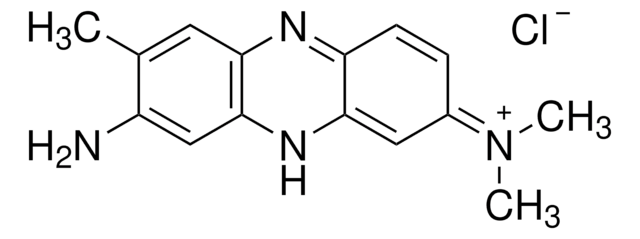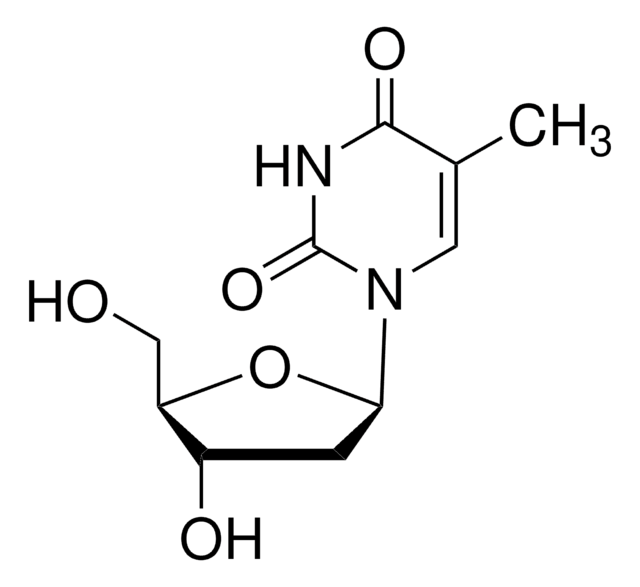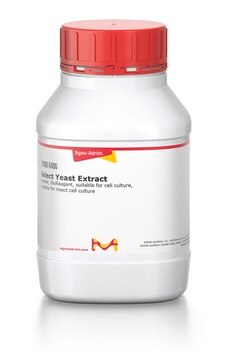T9157
Tryptose Phosphate Broth
suitable for insect cell culture
Synonim(y):
Tryptose Broth
Zaloguj sięWyświetlanie cen organizacyjnych i kontraktowych
About This Item
Kod UNSPSC:
41106507
NACRES:
NA.73
Polecane produkty
pochodzenie biologiczne
bovine milk
Postać
solid
metody
cell culture | insect: suitable
Warunki transportu
ambient
temp. przechowywania
room temp
Opis ogólny
Tryptose Phosphate Broth (TPB) comprises pyrimidine based components and is crucial for pyrimidine synthesis and electron transport chain in cells. In chick embryo fibroblast, it alleviates chloramphenicol inhibition.
Zastosowanie
In addition to its use for the growth of fastidious micro-organisms, Tryptose Phospate Broth (TPB) has been studied as supplement for the preparation of media that supports vaccine production in BHK-21 cells and the growth of SF21 insect cells in high-density perfusion culture stirred-tank bioreactors.
Tryptose Phosphate Broth has been used as a supplement:
- in Eagle′s minimum essential medium alpha for growing Vero cells
- for Vero-CCL81 cells in porcine epidemic diarrhea coronavirus propagation
- in Dulbecco modified Eagle medium in LR7cells for mouse hepatitis virus propagation
- in Glasgow minimum essential medium (GMEM) for Madin-Darby canine kidney (MDCK) cells.
Komponenty
Tryptose Phosphate Broth (TPB) is composed of four components: Tryptose (20g/L); Dextrose (2g/L); NaCl (5g/L) and Disodium Phosphate (2.5g/L) typically adjusted to pH 7.3. The tryptose component is a peptone (mixture of amino acids and short peptides) derived by the mixed enzymatic hydrolysis (pancreatic enzymes) of the milk protein casein. This hydrolysate provides a source of amino acid based nutrients and survival factors that support the growth of fastidious micro-organisms such as Brucella, Streptococcus, and Neisseria; as well as eukaryotic cells such as insect and animal cells. Dextrose provides a fermentable carbohydrate that can be used by fastidious mico-organisms. Sodium chloride maintains the osmotic and ionic equilibrium and disodium phosphate provides the basic buffering capacity.
This page may contain text that has been machine translated.
najczęściej kupowane z tym produktem
Numer produktu
Opis
Cennik
Kod klasy składowania
11 - Combustible Solids
Klasa zagrożenia wodnego (WGK)
WGK 3
Temperatura zapłonu (°F)
Not applicable
Temperatura zapłonu (°C)
Not applicable
Środki ochrony indywidualnej
Eyeshields, Faceshields, Gloves, type P3 (EN 143) respirator cartridges
Certyfikaty analizy (CoA)
Poszukaj Certyfikaty analizy (CoA), wpisując numer partii/serii produktów. Numery serii i partii można znaleźć na etykiecie produktu po słowach „seria” lub „partia”.
Masz już ten produkt?
Dokumenty związane z niedawno zakupionymi produktami zostały zamieszczone w Bibliotece dokumentów.
Klienci oglądali również te produkty
Aminopeptidase N is not required for porcine epidemic diarrhea virus cell entry
Li W, et al.
Virus Research, 235, 6-13 (2017)
Tryptose phosphate broth improves Rickettsia felis replication in mammalian cells
Saisongkorh W, et al.
FEMS Immunology and Medical Microbiology, 64(1), 111-114 (2012)
Identification and characterization of a proteolytically primed form of the murine coronavirus spike proteins after fusion with the target cell
Wicht O, et al.
Journal of Virology, 88(9), 4943-4952 (2014)
Phytochemical analysis and in-vitro screening of selected Indian medicinal plants for antiviral activity against highly pathogenic avian influenza virus
Sood R, et al.
Spatula DD, 3(3), 81-88 (2013)
S N Saha et al.
Vaccine, 7(4), 357-363 (1989-08-01)
Studies were undertaken to develop a cheaper medium with indigenous sources of peptone and casein hydrolysate for continuous culture of BHK-21 (suspension) cells and production of foot-and-mouth disease (FMD) vaccine. Eleven batches of experimental media were prepared using different indigenous
Nasz zespół naukowców ma doświadczenie we wszystkich obszarach badań, w tym w naukach przyrodniczych, materiałoznawstwie, syntezie chemicznej, chromatografii, analityce i wielu innych dziedzinach.
Skontaktuj się z zespołem ds. pomocy technicznej
















